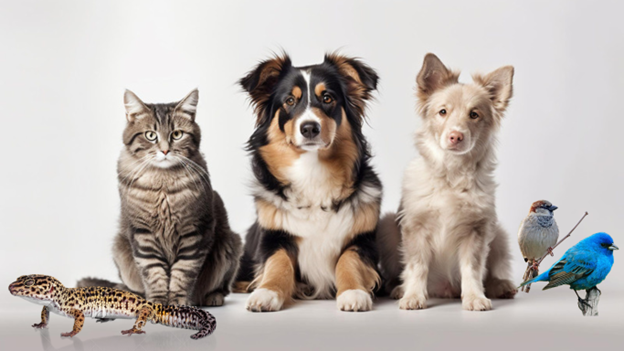
Nail Trimming: A Comprehensive Guide for Dogs, Cats, Birds, and Lizards
Why Nail Trimming is Important for Pets?
Proper nail trimming is important for your pets because it improves the overall health of your pets. When a nail grows too long it causes various issues:
- Overgrown nails cause a lot of discomfort and interfere with the ability of your pet to walk and maintain proper posture, which further results in long-term musculoskeletal problems.
- Long nails are more prone to get caught in furniture, carpets, or other objects, which leads to torn nails and injuries.
- Untrimmed nails cause undesirable behaviors, like cats scratching, and dogs and other pets may start chewing.
- The most important thing is that overgrown nails grow back into the pads of your pets which leads to discomfort and infections.
- Long nails also make cleaning and grooming more difficult and it leads to poor hygiene.
How Often Should You Trim Your Pet’s Nails?
The frequency of nail trimming in pets depends on the species, age, breed, and activity level. A general guideline for each category is:
Dogs
- Small and Indoor Dogs: Every 3-4 weeks.
- Medium and Active Dogs: Every 4-6 weeks.
- Large and Working Dogs: Every 6-8 weeks.
- Puppies: Check their nails every 2-3 weeks and make sure they are not overgrown.
Cats
- Indoor Cats: Every 3-4 weeks.
- Outdoor Cats: They don’t need frequent trimming because their nail wears down naturally.
Birds
- Small Birds: Every 2-4 weeks.
- Medium Birds: Every 4-6 weeks.
- Large Birds: Every 6-8 weeks.
- Preening: Birds usually manage their nails through preening, but it’s important to check them regularly.
Lizards
Lizard nail trimming varies a lot, and it’s important to consult with a vet to determine the needs of your lizards.
How to Guide? Different Animals, Different Techniques
There are specific nail-trimming techniques for cats, dogs, birds, and lizards. Here we will discuss each one in detail:
Nail Trimming for Dogs
- You will need supplies like a grinder, nail clipper, styptic powder (for accidental bleeding), and some treats for your pet.
- Make sure your pup is relaxed and comfortable and if it’s the first time for your dog then start the process slowly by touching their paws and giving them a treat to provide positive association.
- Take a nail clipper or a grinder to trim your pup’s nails. Gently hold the paw of your pup in your hand and trim the tip of the nail. If an accident happens and you cut the quick the bleeding will start. In this situation use styptic powder to stop bleeding.
- You have to be cautious for dark-colored nails because quick is not visible, give small cuts to avoid cutting the quick.
- Use treats and praise for successful nail trimming sessions and to create a positive experience for your dog.


Nail Trimming for Cats
- Cats are very active so you need a towel to gently wrap you’re your kitty, and only leave one paw out at a time.
- Use cat specific nail clipper or grinder as it is made especially for their delicate nails.
- Do not over-trim their nails; cats have retractable claws that always trim the tip of the nail not more than that.
- Use comforting words and treats to create a positive association with your pet as it will ease the process.
- If you are not sure about the trimming process and your cat is resistant, consult a veterinarian or groomer for help.
Nail Trimming for Birds
- The tools you will need for bird nail trimming are small bird-specific nail clippers or nail files, styptic powder, and towels.
- Put your birds in your lap and wrap them in a towel, make sure they are secure and comfortable. By covering their head with you can keep them calm.
- Use very gentle hands to hold the bird’s leg and trim with a nail file or clipper the tip of each nail. Try not to cut the quick as it is the darkest part inside each nail.
- Use treats and toys to keep your bird calm during the grooming session.
- If you are not sure about the process consult a professional for help.


Nail Trimming for Lizards
Nail trimming of lizards is not an easy process and it varies a lot according to the species. It’s important to consult a vet for proper guidance for claw trimming of your lizard. However, some general guidelines are:
- Collecting Supplies: Depending on the species and size of your lizard, you may need to collect nail clippers, a nail file, or even sandpaper. It is better to research your lizard’s requirements carefully.
- Handling: Lizards can be sensitive to stress, so patience is key. It is best to handle your lizard gently and ensure they are relaxed.
- Nail Trimming Technique:
- Some lizards naturally wear down his or her claws through climbing or activity. You can make sure they have suitable environmental enrichment.
- For lizards with overgrown nails, you may need to use a file or clippers. Be careful not to cut into the quick.
- Professional Help: If you are uncertain about how to properly trim your lizard’s nails, seek help from an experienced veterinarian in reptile care.
Conclusion
In conclusion, nail trimming is more than a cosmetic chore; it’s a fundamental aspect of responsible pet care. Neglecting your pet’s nail maintenance can lead to discomfort, pain, and various health issues. However, with the right tools, techniques, and a patient approach, you can ensure your pet’s well-being and enhance the bond you share. By tailoring the frequency and method of nail trimming to your specific pet, whether it’s a dog, cat, bird, or lizard, you can promote their health, mobility, and overall happiness, turning a seemingly minor task into a vital component of your pet’s care routine.
About the Author:
Savanna Westwood
Savanna Westwood is the Owner and Founder of The Savvy Sitter, Pet Sitting and Dog Walking, LLC. She has grown up with animals all her life and enjoys spending time with them. Savanna has lived in the Winter Garden and Windermere Area for over 30 years. When she is not taking care of Fur Friends, one can find her reading, practicing archery, riding, and devising ways to provide additional and excellent services to clients. Savanna is a Certified Professional Pet Sitter with Pet Sitter International's CPPS certification and also holds certification in Pet First Aid and CPCR for Pet-Care Professionals.

